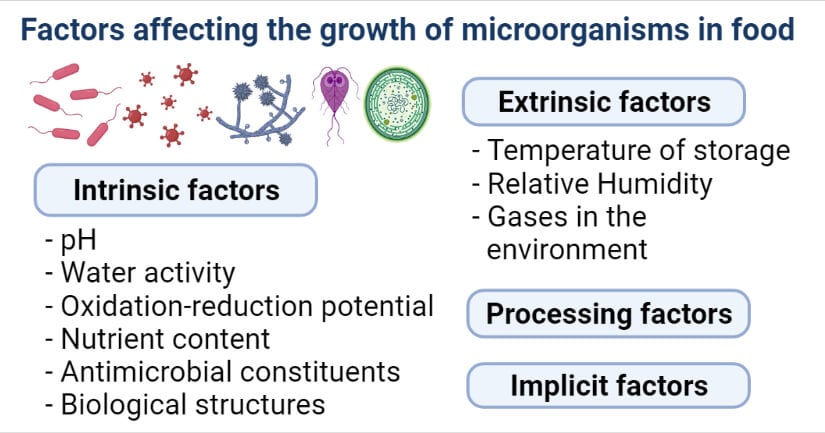Three Conditions Under Which Microbes Will Grow the Best
The infective dose of the pathogenic bacteria. Bacteria like moist conditions.

Microbial Growth An Overview Sciencedirect Topics
The three fundamental requirements related to bacterial life are temperature oxygen and food.

. Bacteria grow best in a neutral PH between 66 and 75. 44 Microaerophiles are microbes that grow best at low A oxygen levels. Some bacteria flourish in the presence of considerable degree of acidity and are termed acidophilic eg lactobacillus.
The presence of Listeria in Nataliyas blood suggests that her symptoms are due to listeriosis an infection caused by L. E carbon dioxide levels. The majority of commensal and pathogenic bacteria grow best at a neutral or very slightly alkaline reaction pH 72 to 76.
Bacteria can live in hotter and colder temperatures than humans but they do best in a warm moist protein-rich environment that is pH neutral or slightly acidic. It is not possible however to identify specific environmental conditions that favor general bacterial growth because bacteria are a vastly diverse group of organisms. Some bacteria thrive in extreme heat or cold while others can survive under highly acidic or extremely salty conditions.
The presence of oxygen can easily effect the growth of a. There are exceptions however. What Three Conditions Are Ideal for Bacteria to Grow.
Moist areas are particularly prone to bacterial. On the other hand M. Mechocidal yeasts are typically mesogens.
The growth of bacteria depends on the environmental ph whether it is acidic or alkaline. An organism that requires oxygen to survive. Bacterial doubling times vary enormously.
Relatively high CO2 and relatively low oxygen concentrations B. Almost every part of the Earth is home to some type of bacteria even the bottom of the ocean and the vast frozen landscapes near the North and South. Bacteria need water to grow and die without a water source.
What Are The 6 Conditions Necessary For Bacteria To Grow. Bacteria can live in hotter and colder temperatures than humans but they do best in a warm moist protein-rich environment that is pH neutral or slightly acidic. Four Conditions for Bacterial Growth Warm Temperature.
All of the bacteria we work with in lab are mesophilic which means that they grow at temperatures between 2040C. A emephile will grow best at moderate temperatures between 20 C and 45 C. Leprae which causes Hansens disease leprosy grows much more slowly with a doubling time of 14 days.
PH level ACIDIC. For example Mycobacterium tuberculosis the causative agent of tuberculosis has a generation time of between 15 and 20 hours. The expected initial level of the pathogenic bacteria in the food.
Bacteria are microscopic single-celled organisms that tolerate an amazing diversity of environmental conditions. An organism that requires a low level of oxygen less than atmospheric normal Match each type of organism with the best description of its oxygen requirements. There are exceptions however.
MonocytogenesListeriosis is a serious infection with a 20 mortality rate and is a particular. The environment where depressant plants grow the best is -015 C while environments where psychrotroph plants thrive at a temperature between 4 x 4 C and 25 x 25 C the best. Bacteria require water to grow and can die without water.
Bacteria grow best at 37C which is body temperature. The acronym FORGTOM is used to describe how bacteria grow at the following factors. Match each type of organism with the best description of its oxygen requirements.
Conditions for bacterial growth There are five main conditions for bacterial growth FATTOM. Most disease-causing bacteria thrive in warm temperatures especially those close to body temperature. Capnophiles are bacteria that grow best under which of the following conditions.
Some bacteria thrive in extreme heat or cold while others can survive under highly acidic or extremely salty conditions. Presence of pathogenic bacteria. They require warm temperature for their growth.
Coli but there are exceptions. Whereas Escherichia coli can double in as little as 20 minutes under optimal growth conditions in the laboratory bacteria of the same species may need several days to double in especially harsh environments. It cannot live on cold and hard surfaces that do not have any moisture and food that is freeze dried is no good to microorganisms.
Can Bacteria Grow At 25 Degrees. The physiological tolerances of microorganisms can vary from species to species too and some kinds of bacteria will thrive in really saline conditions. This example concludes Nataliyas story that started in How Microbes Grow and Oxygen Requirements for Microbial Growth.
Bacteria needs moisture to thrive too. As you will learn bacteria have preferred growth temperatures where their reproduction rate is the greatest. Others are very sensitive to acid but tolerant to alkali eg Vibrio cholerae.
Food acidity time temperature oxygen and moistureIn addition to providing minerals energy and other components for bacterial growth foods offer an ideal environment for bacteria to flourish. However some prefer body temperature 37C while others grow best at room temperature approximately 25C. Most pathogens grow rapidly like E.

Factors Affecting The Growth Of Microorganisms In Food

Comments
Post a Comment